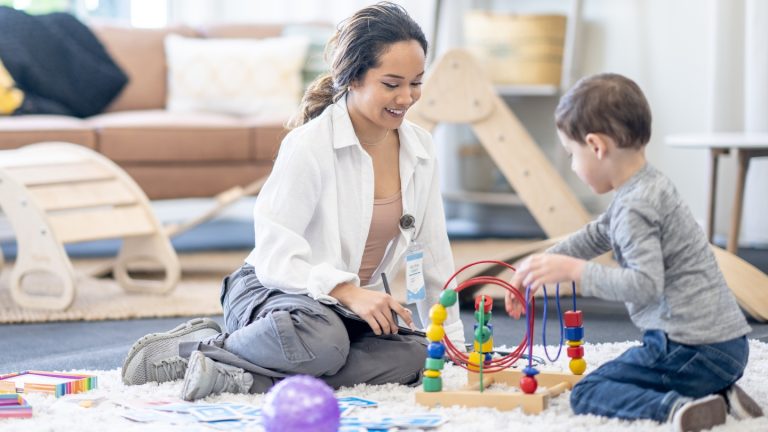
Occupational therapists help individuals regain, develop, or maintain the skills they need for day-to-day activities, fostering greater independence and improving quality of life. These professionals work with people of all ages who are facing physical, mental, or developmental challenges, providing tailored interventions that promote participation in everyday tasks. These activities could range from self-care routines, like dressing and eating, to more complex tasks, like cooking or using a computer. Home visits in occupational therapy are designed to assess an individual’s home environment, and/or provide therapy in a familiar and comfortable setting. This is known as occupational therapy home visit or OT home service.
Occupational therapy home visits are particularly beneficial for those who have difficulty travelling to a clinic, ensuring they receive the necessary support without the added stress of transportation. Additionally, these visits allow therapists to see firsthand the challenges their clients face in their daily environments, making it easier to provide practical and effective solutions. By working within the home, therapists can tailor their recommendations to the specific layout, resources, and routines of the individual, leading to more meaningful and sustainable improvements.
Preparing for an Occupational Therapy Home Visit
Before an occupational therapy home visit, it’s important to understand what to expect. Being well-prepared ensures that the session is productive and that the therapist can gather all the necessary information to provide effective support. After you complete your referral, which at Therapy Partners also includes your preferred day(s) and time(s) for therapy sessions, an occupational therapist will schedule the visit at a time that is convenient. They may ask about the individual’s daily routines, activities they struggle with, and any modifications already in place in the home. This initial information helps the therapist plan a focused and effective assessment.
Preparing for the visit may also involve ensuring the therapist can safely and effectively assess the home environment. This could mean:
- Clearing clutter from walkways
- Making sure the therapist can access all areas of the home
- Having any relevant medical documents ready for review
- Informing the therapist of any pets or potential hazards in the home (or proactively removing them from the environment)
The home environment plays a significant role in the success of the therapy. A thorough assessment can reveal specific obstacles or areas that need adaptation to enhance the individual’s ability to perform daily tasks. A conducive home environment is one that is safe, accessible, and promotes independence. For instance, proper lighting, handrails in strategic places, and non-slip mats can make a significant difference. It’s not about having a ‘perfect’ home, but rather one that supports the client’s therapeutic goals.

The Process of the Home Visit
During the occupational therapy home visit, the therapist will conduct a comprehensive OT home assessment. This assessment is designed to gather detailed information about the client’s living environment, daily routines, and specific challenges they face. This may involve:
- Observing the client performing various tasks
- Assessing the home for safety and accessibility
- Identifying any barriers to independence
During this time, the occupational therapist plays several roles. They are an observer, noting how the client perceives and interacts with their environment. They are also a guide, providing immediate suggestions for improving safety and ease of task completion. Additionally, they are a coach, helping the client learn new ways of doing things or use adaptive equipment. This approach by the OT ensures that all aspects of the client’s daily life are considered and optimised for better functionality.
The types of assessments or interventions during a home visit can vary greatly depending on the client’s needs. Each intervention is tailored to address specific challenges, ensuring personalised and effective therapy. They may include:
- Motor skills assessments
- Cognitive assessments
- Evaluations of the home for fall risks or other safety concerns
- Teaching new strategies for task completion
- Recommending home modifications
- Prescribing adaptive equipment
- Treatments for Vocal Fatigue
Post Home Visit (Follow-ups & Recommendations)
After the occupational therapy home visit, the therapist will provide a summary of their findings and recommendations. This may include an overview of the client’s current abilities and challenges, a treatment plan outlining the goals of therapy, recommended home modifications, or suggestions for adaptive equipment. The summary serves as a roadmap for the client’s therapeutic journey, detailing specific steps and strategies to enhance daily living.
Understanding these recommendations is crucial for the individual’s progress. Clients and caregivers should take the time to review the recommendations carefully. It’s important to ask questions and clarify anything that’s unclear, and ensure they fully understand the purpose and implementation of each suggestion. The therapist is there to help, providing support and guidance throughout the process, making sure that the client feels confident and informed about the next steps.
Follow-up visits and ongoing communication with the occupational therapist are key to ensuring the client is making progress and the home environment continues to support their needs. These follow-ups may simply be additional therapy sessions, or involve further assessments, adjustments to the treatment plan, or additional training in new strategies or equipment use around the house and wider environment. We make sessions work for you, offering flexible scheduling and personalised support to fit into your routine and lifestyle.
Home visits are a vital component of occupational therapy. They allow the therapist to see the client in their own environment and tailor interventions to their specific needs. This personalised approach ensures that therapy is practical, relevant, and effective. The information gained during an OT home service is invaluable in creating a treatment plan that addresses the unique challenges and opportunities present in the client’s daily life, whilst promoting independence and enhancing quality of life.
If you have any questions or would like to learn more about how occupational therapy home visits can benefit you or your loved one, please speak to our team at Therapy Partners. We are here to provide comprehensive support and information to help you make informed decisions. For the best results, it’s important to collaborate with the occupational therapist and maintain open communication. Remember, the goal of occupational therapy is to enable the client to live life to its fullest, and that journey is a team effort.








